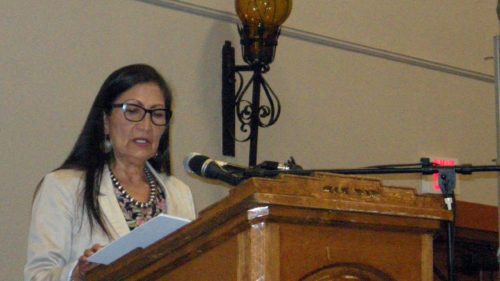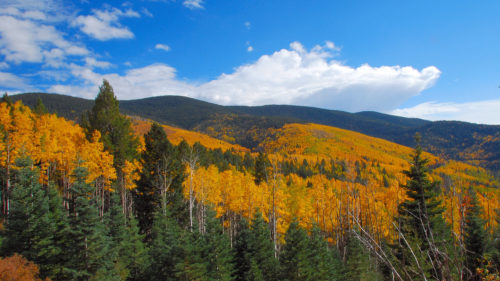(This story first appeared in the Spring 2014 Outdoor Reporter)
New Mexico’s native elk, the Merriam’s, was driven to extinction by market hunting and uncontrolled grazing in the early 1900s, and today little is known about a animal once plentiful throughout the Southwest.
But a century ago, sportsmen decided they wouldn’t have a state without elk. In 1910, a few short years after the last Merriam’s disappeared, far-sighted individuals like New Mexico’s first Territorial Game Warden, Thomas P. Gable, and organizations like the New Mexico Game Protective Association (later known as NMWF) were transplanting small groups of a different sub-species, Rocky Mountain elk, from the Yellowstone region to areas ranging from the Pecos and Sangre de Cristo Mountains to the Jemez, Mt. Taylor and Grant County. The Bartlet Ranch (Vermejo) released 15 elk in 1910. Gable released 12 elk in the Sangre de Cristo Range in 1911.
The Yellowstone elk apparently found New Mexico to their liking. In little more than a century, elk numbers in New Mexico rose from zero to at least 70,000, and perhaps as many as 95,000, according to the most recent population estimates from the Department of Game and Fish.
Judging from the number of depredation complaints and car-elk collisions, some landowners and drivers might argue there are too many elk in New Mexico today, but for hunters there still aren’t enough. Last year more than 58,000 hunters applied for an elk tag in the Big Game Draw, in which only 21,000 tags were available.
The State Game Commission also gave another 19,000 transferable elk authorizations to a relatively small number of landowners to sell, trade or use themselves through the E-PLUS program.
Despite the high demand, New Mexico hunters probably can’t expect to see the number of elk licenses increase dramatically in the near future. Statewide, populations are considered stable to slightly increasing, though it depends on what part of New Mexico you’re talking about. Game and Fish elk biologist Nicole Quintana says some herds are growing slightly while others are slightly declining.
One area where elk numbers are rising is the Sacramento Mountains, GMUs 34 and 36. As with any species, Quintana said, several factors are likely at play, including favorable environmental conditions and possibly lower calf predation rates. In 2012 the Little Bear Fire charred nearly 45,000 acres in and around the White Mountain Wilderness, creating good habitat for elk and other big game.
On the flip side, the population trend in recent years for the Mount Taylor herd (GMU 9) is slightly declining. In response the department cut the number of antlerless licenses there from 600 last year to 365 in the upcoming season, and next year’s proclamation could see even fewer.
Mount Taylor isn’t alone. The Valle Vidal and Jemez herds also have had calf/cow ratios below desirable levels. In both areas, recent studies suggest that predation, especially by black bears, is a leading cause of lower calf/cow ratios. Raising the harvest of black bears on the Valle Vidal has boosted calf/cow ratios there, putting them closer to management objectives, Quintana said.
Elsewhere in New Mexico, elk herds have calf/cow ratios that reflect healthy populations, she said.
All these elk are not affecting mule deer, however, Quintana said. The two species share some of the same foods and habitat, but there is no evidence that elk are forcing mule deer out of particular areas, she said. Rather, elk are considered “generalists” that can survive off a wide range of forage plants. Mule deer “have a more specialized diet and can be more sensitive to changing conditions such as drought or habitat degradation,” she said.
Several dozen landowners file depredation complaints about elk every year, but complaints are not increasing over time, Quintana said. “There will always be differing perspectives on whether there are too many or too few elk in certain areas of New Mexico,” she noted, but Game and Fish continues to recommend harvest strategies that maintain elk herds into the future. “This includes considering social and ecological implications of elk presence on the landscape,” she said.
Nor is poaching a severe biological problem. Poachers can pressure elk herds, causing them to avoid areas they feel are risky. And illegal elk harvest can cause localized problems, Quintana said, “but we don’t feel that it currently has a substantial impact on larger elk populations or herd health.”
Those early elk transplants paid off, just as sportsmen had hoped. The first public-land hunts began in 1933, according to a Game and Fish timeline. Numbers grew and by 1981 hunting had increased enough that the Department adopted a GMU system to distribute hunting pressure. In 1994, the statewide harvest topped 10,000 for the first time.
Hunters enjoyed a steady increase in elk licenses for several decades, but the State Game Commission in 1999 apparently thought the growth was too much and voted to reduce herds in 21 management units. The number of Big Game Draw licenses ballooned to more than 32,000 in 2002, but as herd sizes declined, draw licenses dropped below 21,000 within five years.
Since then elk numbers have stabilized, as have the number of licenses in the Big Game Draw – about 21,000 a year since 2008. In addition, Game and Fish sells nearly 2,000 additional licenses over the counter, through the Youth Encouragement hunts, population management hunts and left-over trophy elk (APRE) hunts.
During the same period, however, the transferable licenses available to landowners enrolled in EPLUS grew by 3,000 licenses – from about 16,300 to more than 19,500. And of those, some 8,000 a year are not used.
Over the last decade, the percentage of licenses allocated through the Big Game Draw has dropped from 63 percent to as low as 51 percent (in 2010-11).
“The numbers don’t lie, and the numbers show that resident New Mexican hunters who rely on the Big Game Draw are not benefiting as much as they should from our increase in elk,” said NMWF Executive Director Garrett VeneKlasen.
The Game Commission has full authority over the size and scope of the private land hunting programs. But unlike Colorado and other states, New Mexico has never had limits on its private land program for elk, and has not had a limit on the antelope program since 1973.
In Colorado, for example, the Ranching for Wildlife program requires that participating ranches have at least 10,000 acres of contiguous deeded land to receive elk tags. And then a percentage of the ranch’s tags go into the public draw. In other words, the rancher gets the tags but the public gets at least some benefit.
New Mexico has no minimum ranch size – ranches as small as one acre can get an elk authorization – and no universal requirement to allow Big Game Draw hunters onto a participating ranch. (Most landowners who receive transferable authorizations can choose whether hunting will be ranch-only or unitwide. Those who choose unitwide must allow hunters on their ranch, but in turn can use their authorizations on public land within a specific GMU.
“The State Game Commission needs to tweak our private land hunting program for elk to provide additional opportunity for resident hunters,” said VeneKlasen. “Unitwide transferable tags give select private landowners an undemocratic entitlement. Why should a private landowner be virtually guaranteed a tag they can use or sell on private AND public land while the rest of us have to put in for the draw to get a chance to draw the exact same tag? They could start by putting a minimum size on participating ranches and by ensuring that any ranch that does receive this amazing public resource – elk licenses – be required to allow at least some public draw hunters.”



